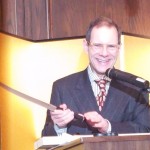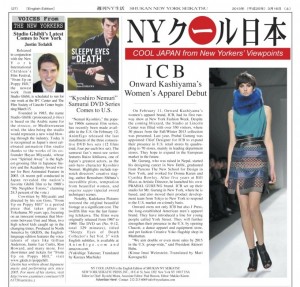Via JETAA UK. Posted by Kay Monroe (Miyazaki-shi, 1995 -97). Click here to join the JETwit Jobs Google Group and receive job listings even sooner by email.
————————————————————————————————————
Position: Senior Broadcast Co-ordinator, BBC World News, Japanese Service
Posted by: TVT Japan
Type: Permanent, full-time
Location: Tokyo
Salary: N/A
Start Date: N/A
Overview:
TVT Japan is responsible for providing the Japanese service of BBC World News. It is part of the TVT group of companies with headquarters in London and offices in Tokyo and Singapore. The group provides translation, versioning and post-production services to Broadcasters all over the world including BBC World News, BBC Worldwide Channels, BBC World Service, UKTV, NBC Universal and Disney.
Responsibilities:
As Senior Broadcast Co-ordinator you will play a vital role in ensuring the overall success of the Japanese Service of BBC World News. Reporting to the Operations Manager you will lead the team responsible for the Japanese versioning of live news and current affairs programming. Read More
Via JETAA DC. Posted by Kay Monroe (Miyazaki-shi, 1995 -97). Click here to join the JETwit Jobs Google Group and receive job listings even sooner by email.
————————————————————————————————————
Position: Associate Producer
Posted by: TV ASAHI America
Type: N/A
Location: DC
Salary: N/A
Start Date: N/A
Overview:
The Washington, D.C. Bureau of TV Asahi, a national Japanese broadcasting company (similar to ABC, NBC or CBS) is currently seeking candidates for a full-time Associate
Producer position:
The Associate Producer will assist the Bureau in its newsgathering, reporting, and production activities for news broadcasts in Japan.
Requirements:
- BA degree minimum; MA degree preferred
- English language fluency required, with strong oral and written communication skills; Japanese language ability a plus, but not required Read More
Job: Consulate General of Japan in Atlanta Employment Opportunity Receptionist (GA)
Posted by Kay Monroe (Miyazaki-shi, 1995 -97). Click here to join the JETwit Jobs Google Group and receive job listings even sooner by email.
————————————————————————————————————
Position: Receptionist
Posted by: Consulate General of Japan
Type: N/A
Location: Atlanta, GA
Salary: N/A
Start Date: N/A
Overview:
Consulate General of Japan in Atlanta is seeking an individual for the position of Receptionist (including Telephone Operator, Assistant for Accounting Section and Translation).
Candidate must be a U.S. citizen or a U.S. green card holder, must be fluent in Japanese and English, and possess computer skills (Microsoft Word and Excel etc. preferred).
To apply for this position, please send your resume to katsumi.isoda@mofa.go.jp.
http://www.atlanta.us.emb-japan.go.jp/cgjaodop.html
Job: CUNY Start – Cooperating Teacher and Writing Assistant (NY)
Thanks to JET alum and JetWit founder Steven Horowitz for sharing this post. Posted by Kay Monroe (Miyazaki-shi, 1995 -97). Click here to join the JETwit Jobs Google Group and receive job listings even sooner by email.
————————————————————————————————————
Position: Various positions including Cooperating Teacher and Writing Assistant
Posted by: The City University of New York
Type: Various
Location: New York, NY
Salary: N/A
Start Date: N/A
Note from Steven:
CUNY Start is a unique and innovative adult education program, and I thought it may be of interest to any JETs or JET alumni seeking to work in adult education. More information available at the website listed above. Additionally, I’m currently teaching in this program and would be happy to answer questions for any JETs or alumni interested in applying.
– Steven
______________________________________________________________
Program Overview:
CUNY Start provides intensive preparation in academic reading/writing, math, and “college success.” The program enrolls prospective CUNY students who have been accepted to college because they have a high school or GED diploma, but are not ready for college-level work based on their scores on the CUNY Assessment Tests.
Students who have enrolled in CUNY Start re-take the required CUNY Assessment Tests. Past students have shown significant skill gains when they re-test; many have bypassed required remedial coursework entirely.
Spring 2013 and Fall 2013 Job Opportunities at CUNY:
- Associate Program Director – CUNY Start
- Cooperating Advisor
- Cooperating Math Teacher
- Cooperating Reading/Writing Teacher
- Writing Assistant
http://www.cuny.edu/academics/programs/notable/CATA/cti-cunystart/cunystart-employmentopps.html
Job: Coordinator for CAPAS (Center for Asian Pacific American Students)
Thanks to JET alum Maria Valenzuela for sharing this post. Posted by Kay Monroe (Miyazaki-shi, 1995 -97). Click here to join the JETwit Jobs Google Group and receive job listings even sooner by email.
————————————————————————————————————
Position: Coordinator for CAPAS (Center for Asian Pacific American Students)
Posted by: Pitzer College
Type: Full-time
Location: Claremont, California
Salary: N/A
Start Date: N/A
Company Information:
CAPAS (Center for Asian Pacific American Students) provides programs and services that focus on Asian American and Pacific Islander (AAPI) issues for a multicultural campus community. The Coordinator is responsible for overseeing the Center’s daily operations, serving as a resource and facilitating programs for AAPI students, raising awareness of issues affecting the AAPI community, training and developing student leaders. Read More
Job: Marketing Intern at POPSUGAR Japan (SF)
Posted by Kay Monroe (Miyazaki-shi, 1995 -97). Click here to join the JETwit Jobs Google Group and receive job listings even sooner by email.
————————————————————————————————————
Position: Marketing Intern
Posted by: POPSUGAR
Type: Summer Internship
Location: San Francisco
Salary: N/A
Start Date: N/A
Company Information:
POPSUGAR, the leader in online media for women and recently named to the “10 San Francisco Tech Companies You Wish You Worked For” by WIRED (http://www.wired.com/business/2012/10/best-san-francisco-tech-companies?…), is looking for an exceptional and passionate individual to join the POPSUGAR Japan team as our Intern! Read More
Justin’s Japan: Studio Ghibli’s Latest Comes to New York
By JQ magazine editor Justin Tedaldi (CIR Kobe-shi, 2001-02) for Shukan NY Seikatsu. Visit his Examiner.com Japanese culture page here for related stories.
Released in conjunction with the New York International Children’s Film Festival March 15, From Up on Poppy Hill, the newest work from Studio Ghibli, is now playing at four locations in New York City.
Founded in 1985, the name Studio Ghibli (pronounced ji-blee) is based on the Arabic name for the sirocco, or Mediterranean wind, the idea being the studio would represent a new wind blowing through the industry. Today it is recognized as Japan’s most celebrated animation film studio thanks to the works of its co-founder Hayao Miyazaki, whose own Spirited Away is the highest-grossing film in Japanese history and the Academy Award winner for Best Animated Feature in 2003. (A recent poll conducted in Japan revealed the nation’s favorite Ghibli film to be 1988’s My Neighbor Totoro, claiming 24.3 percent of the vote.)
Co-written by Miyazaki and directed by his son Goro, From Up on Poppy Hill is a period piece that takes place in Yokohama 50 years ago, focusing on an innocent romance that blossoms between Umi and Shun, two high school kids caught up in the changing times. Produced in North America by GKIDS, the English-language edition features the voice talents of stars like Gillian Anderson, Jamie Lee Curtis, Ron Howard, and many more.
For showtimes and tickets for From Up on Poppy Hill, visit www.gkids.tv/poppyhill.
JET Bloggers’ Food Posts Roundup (3.26.2013)
L.M. Zoller (CIR Ishikawa-ken, Anamizu, 2009-11) is the editor of The Ishikawa JET Kitchen: Cooking in Japan Without a Fight. A writer and web administrator for The Art of Travel, ze also writes I’ll Make It Myself!, a blog about food culture in Japan, and curates The Rice Cooker Chronicles, a series of essays by JETs and JET alumni on the theme of cooking/eating and being alone in Japan, and The JET Alumni Culinary Group in LinkedIn.
New Rice Cooker Chronicles submissions always welcome. Just e-mail it to jetwit [at] jetwit.com.
These posts by JET bloggers were featured on the JET Alum Culinary Group on LinkedIn:
“How to Earn a Black Belt…In Front of the Conveyor Belt” by Alexandra Brueckner (ALT, Aomori, 2011-) at The Globe-Trotting Geek.
This piece about kaitenzushi was Freshly Pressed on WordPress on March 12, 2013. おめでとうございます!
“Weekend: 3月17日: Osaka meals” by Sarah (ALT, Takaoka, 2012-) at Daily Nibbles.
Sarah takes gorgeous photos of Osaka’s famous foods. Takoyaki has never looked this good!
“A quick break at Kiharu” by Brittany (CIR, Matsue, 2012-) at San’in Monogatari.
Brittany drops by a cafe in Matsue for some wagashi and matcha.
Join us on LinkedIn and share your own food stories, blog posts, or articles of interest: http://www.linkedin.com/groups?gid=4803196&trk=hb_side_g
I’ll Make It Myself!: Snow Monkey Beer Live 2013 (スノーモンキービアライブ)
L.M. Zoller (CIR Ishikawa-ken, Anamizu, 2009-11) is the editor of The Ishikawa JET Kitchen: Cooking in Japan Without a Fight. A writer and web administrator for The Art of Travel, ze also writes I’ll Make It Myself!, a blog about food culture in Japan, and curates The Rice Cooker Chronicles, a series of essays by JETs and JET alumni on the theme of cooking/eating and being alone in Japan, and The JET Alumni Culinary Group in LinkedIn.
New Rice Cooker Chronicles submissions always welcome. Just e-mail it to jetwit [at] jetwit.com.
I finally got to attend the 2013 Snow Monkey Beer Live, an annual craft beer and live music festival in Shiga Kogen, Nagano, which took place from March 16-17.
(New Posts) JET Alum Parenting Blog: “US-JAPAN FAM”
 Heather Wilson Tomoyasu (ALT Ibaraki-ken, 2004-06), previously Manager of Public Relations at the Japanese Chamber of Commerce, is now a newly established stay-at-home mom blogging in Brooklyn on her site US-Japan Fam to hopefully compile the ultimate resource for Japanese-American cross cultural families, delving into the matters of raising children bilingually, bi-culturally, and bi-racially in the Big Apple.
Heather Wilson Tomoyasu (ALT Ibaraki-ken, 2004-06), previously Manager of Public Relations at the Japanese Chamber of Commerce, is now a newly established stay-at-home mom blogging in Brooklyn on her site US-Japan Fam to hopefully compile the ultimate resource for Japanese-American cross cultural families, delving into the matters of raising children bilingually, bi-culturally, and bi-racially in the Big Apple.
 Dreamy Destination Wedding: Three years ago I today we tied the knot, got hitched, jumped the broom, or whatever you like to call it! I walked down the virgin road (that’s what they call the aisle in Japan!! HA!!) in Hawaii of all places!! I’d never been there before, but it seemed like the perfect romantic and beautiful halfway meeting ground for our family and friends to join from America and Japan (as well as from Canada, Australia, and England)… <CONTINUE>
Dreamy Destination Wedding: Three years ago I today we tied the knot, got hitched, jumped the broom, or whatever you like to call it! I walked down the virgin road (that’s what they call the aisle in Japan!! HA!!) in Hawaii of all places!! I’d never been there before, but it seemed like the perfect romantic and beautiful halfway meeting ground for our family and friends to join from America and Japan (as well as from Canada, Australia, and England)… <CONTINUE>
Victor-Victoria, or more like Rick-Riku?: Little Kenzo was born with 100% Japanese eyes. No crease or double eyelid or whatever you call it. They were just like daddy’s and gorgeous! Fast forward 2 months and overnight he developed the double lid… in ONE EYE… <CONTINUE>
Go to the blog to see more posts!!
Comments on entries are always appreciated, and guest bloggers are welcome to use the contact form on the blog site to submit ideas!
JETwit note: CLICK HERE to join the JET Alumni Parents group on Facebook.
JET alum Lucia Brea interviewed by NY Public Library Blog about JET Program
The New York Public Library Blog recently interviewed JET alum Lucia Brea (Fukui-ken) about her experience on the JET Program:
STUFF FOR THE TEEN AGE, THE TICKETLESS TRAVELER
Think Japan is all Manga, Sushi, and Pocky Sticks?
by Rabecca Hoffman, Kingsbridge Library
March 21, 2013
Harajuku? Geisha? Robots? Awesome! Japanese culture has been an obsession of mine for a while now, as well as for the teenagers at my branch, so when we recently had the opportunity to invite Lucia Brea, Fukui Friendship Ambassador, to stop by and talk to the Kingsbridge Library’s Teen Advisory Group, I jumped at the opportunity. Lucia spent four years in Japan through the JET Program teaching English to students of all ages in the Fukui Prefecture, and I was able to sit down with her after her visit to ask her a few questions about her experience:
What is the JET program, and would you recommend it for other people? Are there other ways to go about living in Japan as a foreigner?
The JET Programme stands for Japan Exchange and Teaching Programme, now in its 26th year, which aims to promote grass-roots international exchange between Japan and other countries. I would highly recommend it to anyone who has a passion for developing strong relationships with communities and the drive to live in Japan for an extended period of time. It is an opportunity to experience Japan and continue to enhance relationships between Japan and their home country like I did at the New York Public Library. There are many other ways to live in Japan as a foreigner, the JET Programme is one of the best…
CLICK HERE to read the full article on the New York Public Library site.
Himeji Castle – Reconstruction
Posted by Benjamin Martin, a 5th year JET on Kume Island in Okinawa, publisher of the blog MoreThingsJapanese.com and author of the YA fantasy series Samurai Awakening (Tuttle).
 Himeji Castle in Hyogo Prefecture is hailed as the most fabulous of Japan’s many castles. It is definitely the largest. I had the opportunity to visit Himeji for a half-day at the start of March in 2013. Himeji Castle is a UNESCO World Hertiage site.
Himeji Castle in Hyogo Prefecture is hailed as the most fabulous of Japan’s many castles. It is definitely the largest. I had the opportunity to visit Himeji for a half-day at the start of March in 2013. Himeji Castle is a UNESCO World Hertiage site.
Restoration
Over the past several years, the main keep of Himeji Castle has been covered by a giant scaffolding that is essentially a building that encircles the high roof. The internal structure has been reinforced to prevent earthquake damage, while the plaster and roofing tiles have been replaced or reworked for water and fire proofing.
The last major restoration of the castle was completed in 1964. This new reconstruction is similar to the first. When I visited the restoration work was nearly complete. I had the opportunity to travel to the top of the scaffolding and view the roof from the outside, a view that will disappear in 2014 as the scaffolding is disassembled and the main keep re-opened. Despite the construction work, I found the grounds beautiful and interesting. Though the inner keep is not accessible, much of the rest of the grounds were, including the West Bailey. It was a great way to spend a few hours strolling through the castle grounds and trying to snap a few photos.
 Throughout the grounds there are multilingual plaques describing many aspects of the history and culture of the castle including its reconstruction and maintenance. Many crests of past lords who reigned at the castle, many worked into the roofing tiles. In the Egret’s Eye View, I was even able to observe a live demonstration of the tiling work. I’ve always found Japanese style tile roofs to be interesting, so it was great to see how they and the walls were actually put together.
Throughout the grounds there are multilingual plaques describing many aspects of the history and culture of the castle including its reconstruction and maintenance. Many crests of past lords who reigned at the castle, many worked into the roofing tiles. In the Egret’s Eye View, I was even able to observe a live demonstration of the tiling work. I’ve always found Japanese style tile roofs to be interesting, so it was great to see how they and the walls were actually put together.
Himeji Castle is located in Hyo prefecture at 68 hon-machi, Himeji, Hyogo. Hours of operation are 9 am to 4 pm (September through April) and 9 am to 5 pm (May to August). Closed December 29 and 30. The Egrets Eye closes a bit earlier.
For more pictures from Himeji Castle please checkout my post at www.MoreThingsJapanese.com
Job: Postings from Idealist.org 3.21.13
Via Idealist.org. Posted by Geneva Marie (Niigata-ken 2008-09) Geneva is a contributor to both JETwit and JETAANY. Geneva is on a continuous (epic) search for Japanese-related jobs in the United States. Click here to join the JETwit Jobs Google Group and receive job listings even sooner by email.
Asian/Pacific Island Diaspora Community Coordinator
Posted by: Oberlin Coordinator
Type: Full-time
Location: Oberlin, OH
Salary: Salary is competitive and commensurate with experience and skills for an entry level administrative position
Start Date: July 1, 2013
The Division of Student Life and Services at Oberlin College seeks applications for the position of Asian/Pacific Island Diaspora Community Coordinator in the Multicultural Resource Center (MRC). This is a full-time, twelve-month Administrative and Professional Staff position, reporting to the Associate Dean of Academic Diversity/Director of the Multicultural Resource Center. B.A. degree, required. Experience with Microsoft Office including Excel, Adobe Photoshop, Adobe InDesign, Google Docs and website management, preferred.
http://www.idealist.org/view/job/cTNJW29GBgW4/
Communications Assistant
Posted by: The Asia Foundation
Type: Full-time
Location: San Francisco, CA
Salary: Not Specified
Start Date: Not Specified
The Asia Foundation is seeking a Communications Assistant for its San Francisco office’s Global Communications unit. Bachelor’s degree in Communications, Public Relations, or in Fine Arts, Design, Photography, International Relations, or related field, required. Minimum 2 years professional experience in web content/production as an editor, designer, or communications professional, preferred.
http://www.idealist.org/view/job/3kzKBBMGdcH4/
Program Assistant, Critical Language Scholarship Program
Posted by: American Councils for International Education
Type: Full-time
Location: Washington, DC
Salary: Not Specified
Start Date: Not Specified
ACTR/ACCELS is seeking a Program Assistant who will assist in the recruitment and selection of applicants and the administration of intensive overseas summer language institutes for U.S. graduate and undergraduate students. Responsibilities include assisting with a variety of program logistics and clerical tasks, and responding to inquiries. Bachelor’s degree required; experience in study abroad or working overseas preferred.
http://www.idealist.org/view/job/5wXPjTCfd9MD/
Program Officer
Posted by: The Asia Foundation
Type: Full-time
Location: San Francisco, CA
Salary: Not Specified
Application Deadline: April 1, 2013
The Asia Foundation is seeking a Program Officer for its San Francisco office’s Digital Media and Technology Programs unit. The Program Officer’s primary roles and responsibilities will include supporting The Asia Foundation’s information and communications technology for development (ICT4D) projects and digital media development and implementation efforts in collaboration with field offices and headquarters units. Masters degree in a technology, business, or international development field, required.
http://www.idealist.org/view/job/8b2w8bz5bcxd/
I’ll Make It Myself!: A Bento is Not As Big As the World
L.M. Zoller (CIR Ishikawa-ken, Anamizu, 2009-11) is the editor of The Ishikawa JET Kitchen: Cooking in Japan Without a Fight. A writer and web administrator for The Art of Travel, ze also writes I’ll Make It Myself!, a blog about food culture in Japan, and curates The Rice Cooker Chronicles, a series of essays by JETs and JET alumni on the theme of cooking/eating and being alone in Japan, and The JET Alumni Culinary Group in LinkedIn.
New Rice Cooker Chronicles submissions always welcome. Just e-mail it to jetwit [at] jetwit.com.
This is a companion piece to “‘Deeply Ingrained Advantages’: American Media Discovers Kyûshoku.”
At the same time as Japan’s school lunch programs got picked up by the media, there was a burst of articles about Japan’s other distinctive lunch: the bento.
Bento and the Cult of Cute
In the lead-in to Carlsen’s and Turner’s “In Japan, Food Can Be Almost Too Cute To Eat,” there is a slideshow showcasing the cuter side of Japanese food: tofu character goods, a kyaraben (character bento), and images of Anpanman in cartoon and pancake form.
WIT Life #228: Japan Week!
WIT Life is a periodic series written by professional Writer/Interpreter/Translator Stacy Smith (Kumamoto-ken CIR, 2000-03). She starts her day by watching Fujisankei’s newscast in Japanese, and here she shares some of the interesting tidbits and trends together with her own observations.
Yesterday began the second annual Japan Week here in NYC, a bit of a misnomer as it only goes for the three days of March 19-21. The venue is Grand Central Terminal’s Vanderbilt Hall, where you can find 18 booths featuring Japanese food, drink and culture. Last night I was lucky enough to attend a kick-off event at the Japanese ambassador’s residence that highlighted Japan’s unique food culture and traditional arts.
One of the gue st speakers was Michael Romano, director of culinary development for Union Square Hospitality Group, whose restaurants include Union Square Cafe and Gramercy Tavern. Romano was also instrumental in the creation of Union Square Tokyo in 2007. He spoke of his love affair with Japan which began later in life, but has become a full-fledged passion. Romano espoused his devotion to Japanese knives, and shared how a craftsman in Sakai, a city once known for samurai swords but now famous for its kitchen knives, made him a Read More
st speakers was Michael Romano, director of culinary development for Union Square Hospitality Group, whose restaurants include Union Square Cafe and Gramercy Tavern. Romano was also instrumental in the creation of Union Square Tokyo in 2007. He spoke of his love affair with Japan which began later in life, but has become a full-fledged passion. Romano espoused his devotion to Japanese knives, and shared how a craftsman in Sakai, a city once known for samurai swords but now famous for its kitchen knives, made him a Read More





